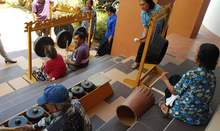Demographics of Sabah
[4] In 1980, the state experienced a sharp rise in population with the arrival of almost a million refugees fleeing the Moro conflict in the neighbouring southern Philippines.
[3][5] Around the same time, large numbers of legal workers from both Indonesia and the Philippines also arrived in Sabah, drawn by the economic boom in its primary sector.
[6][7] Malayising policies enacted under Mustapha Harun further lowered Sabah's Christian Kadazan-Dusun demographic dominance other than these factors.
[11] While the total number of illegal immigrants (including refugees) is predicted to be more than one million,[note 1] most of these people are believed to have been categorised as "other bumiputera" in national statistics.
The East Coast Bajau mostly spend their lives in the sea and settled around the area of Semporna, Lahad Datu, and Kunak;[34][35][36] they also hold their annual regatta lepa festival.
Once known as seafarers, the West Coast Bajau started to learn farming and cattle rearing since their migration from the Philippine archipelago a long time ago.[when?
[38] The Muruts have a great knowledge of botanical healers, with each of their communities having its own herbalist who can attend to illnesses such as diarrhoea, diabetes, and high blood pressure.
[48] The indigenous Suluks are different from the recently arrived Tausug immigrants from the Philippines as they have embraced the multiculturalism in northern Borneo.
These intermarriages date back to the mid-18th century and have resulted in distinct sub-groups like Sino-Kadazan, Sino-Dusun and Sino-Murut, each reflecting a fusion of Chinese and local traditions.
For instance, Sino households may include indigenous delicacies like Linopot and sambal Tuhau in their traditional Chinese New Year menus.
These include the Rungus, Orang Sungei, Iranun, Bonggi, Kwijau, Paitan, Lun Bawang, Lundayeh, Kedayan, Iban, Binadan, Bisaya, Kokos, Rumanau, Lotud, Minokok, Tidung, Kagayan, Tatana, Tagaas, Ubian, Kimaragang, Bajau Laut, Ida'an, Inokang, and Sonsogon.
For example, there was speculation that the term was misused to include counting Filipino and Indonesian immigrants who were naturalised either through some connivance elements in state bureaucracy or fraudulent documents.
[66] The significant increase in the Muslim population between 1980 and 2010 (almost half a million people for every 10 years) highlights the height of Project IC, an alleged demographic engineering program in Sabah.
Starting in the colonial period, various Christian groups from the West actively evangelised the indigenous people of North Borneo as part of an effort to improve the living standards of the natives and eradicate tribal wars, headhunting, and excessive alcohol consumption.
[81] The organisation expelled a number of Christian missionary workers, converted elite politicians, and carried out mass conversion of animist villagers and some older Chinese generations in exchange for their citizenship, office positions, or cash rewards.
[77][83][84] These immigrants were eventually integrated into the community and naturalised as Sabahan and Malaysian via an alleged program called Project IC.
Peninsular Malaysia politicians were brought in to strategise the downfall of PBS by any means (including Project IC) in the pretense of protecting Islam.
This led to highly controversial issues, such as when Christian or pagan indigenous natives were instead identified as Muslim during their applications for identity cards.
[85] This confusion was partly due to federal authorities in Peninsular Malaysia assuming that the usage of "bin" and "binti" in the birth certificates of indigenous non-Muslim Sabahans indicated their profession to Islam.
[94] Prior to this, there were frequent calls to the government to restore the freedom of religion in the state and prevent religious tensions from damaging peace and harmony.
It comprises the Kadazan Dusun language, which has dialects spread throughout the districts of Papar, Penampang, Kota Kinabalu, Tuaran, Ranau, Tambunan, and Keningau.
[101] Zamboangueño, a Spanish-based creole language and dialect of Chavacano, spread into one village of Sabah in Semporna prior to the migration of people from the southern Philippines.
[112] The connection and movement of people between Sabah, Sarawak, Brunei, the southern Philippines, and the Indonesian province of Kalimantan have existed for centuries.
[123] In modern times, prior to laws and lawlessness issues created by recent immigrants, there was an emphasis to control and monitor illegal movements.
[123] The Filipino refugees in Sabah were welcomed by certain state politicians (mostly from USNO, BERJAYA, and the dominant federal government political party of UMNO) to increase the racial balance in favour to the Malays.
The Indonesian community is composed mostly of Buginese, Florenese, Torajans, and Timorese people who have come to Sabah to work as labourers, in oil palm plantations or as domestic workers.
[16] There are many reports stating that following the influx of refugees and foreigners from the Muslim areas of Mindanao in the Philippines and Sulawesi in Indonesia, a "secretive taskforce" was established in the 1970s during Mustapha Harun's term as Chief Minister to register them as citizens.
[12] This complicated estimate was a result of frequent "controversial regularisation", with illegal immigrants and refugees changing their status to "legal citizen".
As a case example, in 2016, a local woman living in Sabah and born to a Sabahan indigenous family was denied citizenship by the state government, whereas recently arrived immigrants had acquired their Malaysian identity card (MyKad) in just a short time despite not having any relationships with Malaysian citizens:[134] I was born at home at Kg Enubai (Tenom District) in 1960, so my birth was not registered then.
Repeated occurrence of such cases has caused the department to be accused of practising religiously motivated "cleansing" of the state to systematically Islamize its people.











(click image to enlarge)


